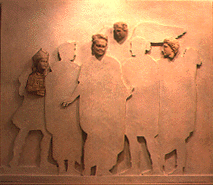

The Templum Gentis Flaviae as Temple and Tomb
Allusions to the apotheosis of Flavian emperors appear in several of the Hartwig-Kelsey fragments. The griffins in the frieze of the entablature are emblems of apotheosis. The comparatively idealized features and serene expression of the Hartwig-Kelsey Vespasian resemble posthumous portraits of the deified emperor more than portraits created during his lifetime, which tended toward unflattering realism and captured Vespasian's notorious "strained expression" (Suetonius, Vesp. 20).
 In
the reconstructed adventus panel of the Templum Gentis Flaviae,
Vespasian mingles with divine personifications as well as human soldiers
and is taller than both. This is significant because height often indicates
status in Roman art.
In
the reconstructed adventus panel of the Templum Gentis Flaviae,
Vespasian mingles with divine personifications as well as human soldiers
and is taller than both. This is significant because height often indicates
status in Roman art.
If, as seems probable, the religious procession represents the inaugural sacrifice at the Templum Gentis Flaviae, this scene would also commemorate the deification of members of the Flavian family interred therein.
At the same time, the sculptures of the Templum Gentis Flaviae pay due homage to Flavian military achievements. The caryatids and palm trees of the precinct wall symbolize Judaea capta, the conquered province. Moreover, Vespasian in the adventus panel enters Rome after a double military success. He is not only triumphator over foreign enemies in Judaea but also victor in the internecine Civil War of AD 68-69.
The multivalent messages of the Templum Gentis Flaviae all sounded variations on two themes: the continuity of the Flavian dynasty and the eventual apotheosis of Domitian. In this sense, the Templum Gentis Flaviae was doomed to become a monument to unrealized ambitions. When Domitian was assassinated in AD 96, not long after an ominous bolt of lightning struck the Templum Gentis Flaviae, the last Flavian emperor died childless and was denied deification by a hostile Roman Senate.
Copyright ©1997, 2002 Ministero per i Beni Culturali e Ambientali, Soprintendenza Archeologica di Roma and the Kelsey Museum of Archaeology, University of Michigan. All rights reserved.
 |
 |
 |
 |
 |
 |
 |
 |
 |